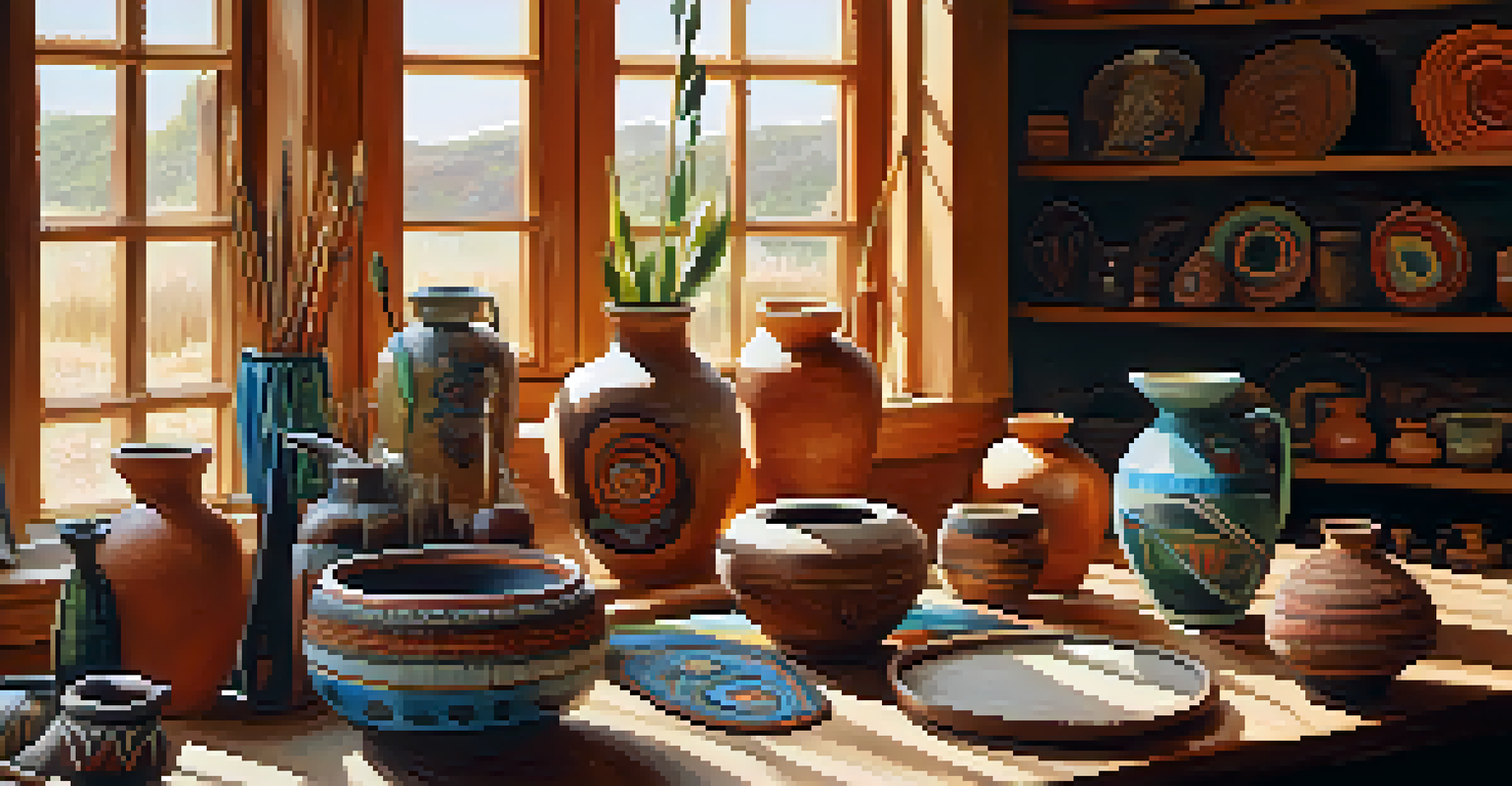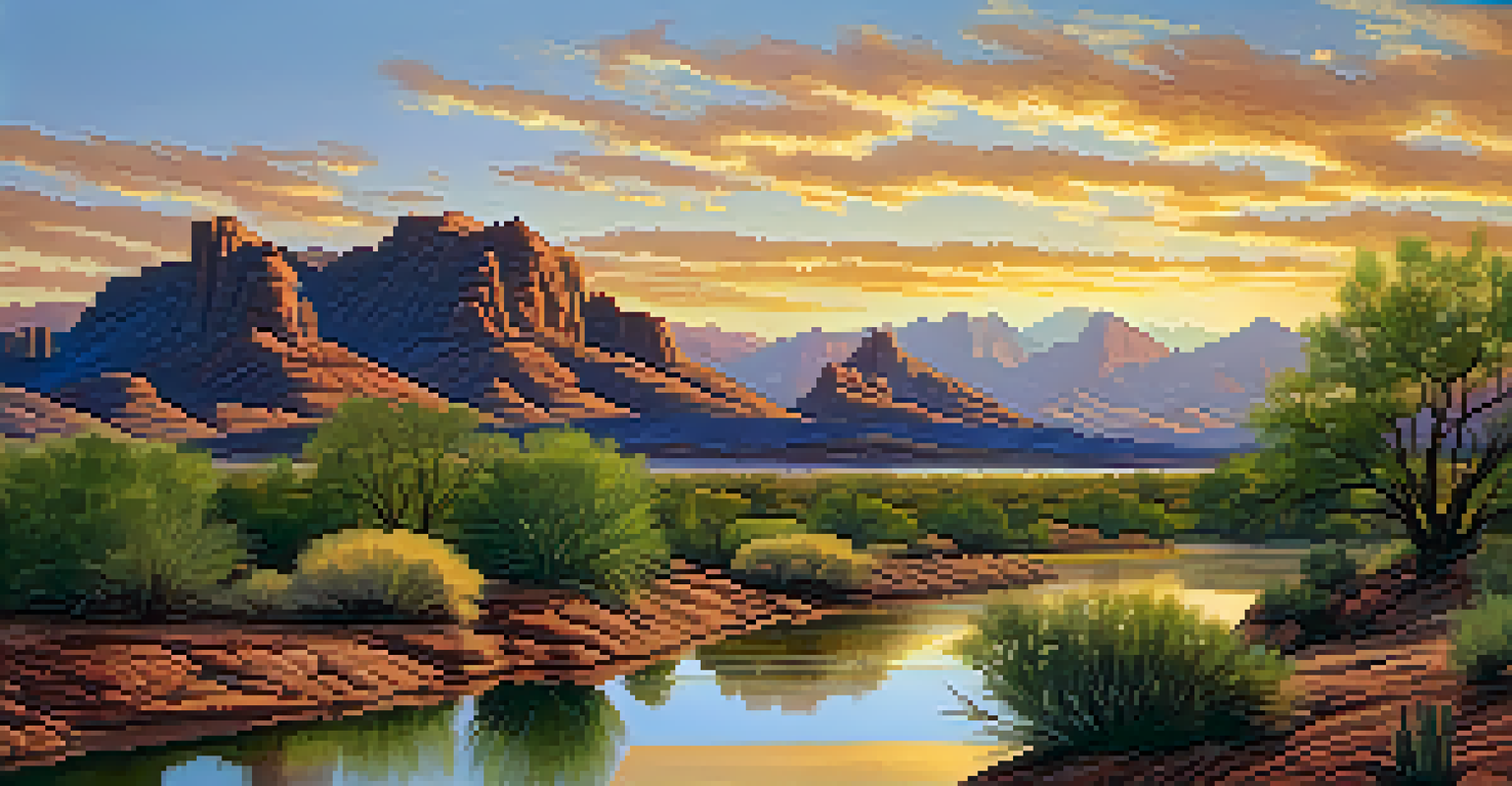Phoenix: A Meeting Point for Native American Cultures

The Rich Tapestry of Native American Cultures in Phoenix
Phoenix is a melting pot of Native American cultures, representing various tribes like the Apache, Navajo, and Hopi. This diversity enriches the city, making it a vibrant hub for cultural exchange and understanding. Each tribe brings its unique traditions, languages, and histories, creating a colorful tapestry that is uniquely Phoenix.
We are as much a part of this land as the land is a part of us.
The city's location, surrounded by sacred mountains and rich landscapes, holds deep significance for many tribes. For instance, the Salt River and Gila River are not just geographical features; they are integral to the cultural identity of the communities that have thrived there for centuries. This connection to the land fosters a deep respect for nature prevalent among the Native American populations.
Events like the annual Phoenix Indian Center’s Pow Wow showcase this cultural richness, attracting visitors from all over. These gatherings not only celebrate traditional dances, crafts, and foods but also highlight the importance of community and heritage. It's a dynamic platform where stories are shared, and connections are made, reinforcing the vibrant spirit of Native American cultures.
Historical Significance of Native American Presence in Phoenix
The history of Native Americans in Phoenix dates back thousands of years, long before the city was established. Archaeological sites reveal that the Hohokam people thrived in this area, developing advanced irrigation systems and agricultural practices. Their legacy is evident in the remnants of their canals and villages that can still be explored today.

As settlers moved in, the Native American population faced numerous challenges, including displacement and cultural assimilation. However, many tribes adapted while fiercely preserving their identities and traditions. This resilience is a testament to the strength of these communities, which continue to thrive in modern society.
Diverse Native Cultures in Phoenix
Phoenix is enriched by the unique traditions and histories of various Native American tribes, fostering a vibrant cultural exchange.
Today, the historical narratives of these tribes are being revitalized through educational programs and cultural initiatives. Museums, such as the Heard Museum, play a pivotal role in this, offering exhibits that honor the rich histories and contributions of Native Americans in Arizona. This commitment to preserving history fosters a deeper understanding and appreciation among all visitors.
The Role of Art in Native American Cultures
Art is a vital expression of Native American culture, often reflecting spiritual beliefs, historical events, and daily life. In Phoenix, art galleries and cultural centers showcase works from local Native American artists, allowing them to share their stories through various mediums. This artistic expression serves not only as a form of storytelling but also as a way to keep traditions alive.
Art is the most beautiful of all lies; it is a testament to the human experience and the stories we share.
Traditional crafts such as pottery, weaving, and beadwork hold cultural significance, often passed down through generations. These crafts are not just beautiful; they represent the skills and knowledge of ancestors. For instance, Hopi pottery is renowned for its intricate designs and techniques, which tell stories of the tribe's history and relationship with the earth.
Moreover, contemporary Native American artists are blending traditional themes with modern techniques, creating a unique fusion of old and new. This evolution in art reflects the changing dynamics of culture while still honoring the past. Exhibitions in Phoenix often highlight this blend, showcasing how art remains a powerful medium for cultural expression and identity.
Cultural Events Celebrating Native American Heritage
Phoenix hosts various cultural events that celebrate Native American heritage, creating opportunities for education and connection. The annual Heard Museum Guild Indian Fair & Market is one of the largest events, featuring Native artists, performers, and a marketplace filled with handcrafted goods. These events not only bolster the local economy but also foster community pride.
Powwows are another significant aspect of cultural expression in Phoenix, bringing together tribes for celebration and camaraderie. These events showcase traditional music, dance, and storytelling, allowing participants and spectators to experience the richness of Native cultures firsthand. It's a vibrant atmosphere filled with colors, sounds, and a sense of community.
Cultural Diversity in Phoenix
Phoenix showcases a rich tapestry of Native American cultures, highlighting the diverse traditions and histories of tribes like the Apache, Navajo, and Hopi.
These gatherings serve as a reminder of the resilience and vitality of Native American cultures in an urban setting. They invite all residents and visitors to engage with and learn from the traditions and histories that have shaped the region. The spirit of these events is rooted in unity and shared experience, making Phoenix a dynamic place for cultural exchange.
Education and Native American Culture in Schools
Education plays a crucial role in preserving Native American cultures, and many Phoenix schools are incorporating Indigenous studies into their curricula. By teaching students about the diverse histories and cultures of Native American tribes, schools foster respect and understanding among young learners. This initiative is essential for breaking down stereotypes and promoting inclusivity.
Programs often include field trips to local museums and cultural centers, where students can engage with Native American artists and historians. These hands-on experiences allow students to gain a deeper appreciation for the traditions and challenges faced by these communities. By learning directly from Native voices, students can connect more personally with the material.
Additionally, partnerships between schools and Native organizations empower Indigenous students to embrace their heritage. Initiatives like cultural immersion programs offer students opportunities to explore their roots while sharing their experiences with peers. This culturally relevant education enriches the community as a whole, creating a more informed and empathetic society.
The Impact of Modern Technology on Native American Cultures
In today's digital age, technology plays a vital role in the preservation and promotion of Native American cultures. Social media platforms allow artists and activists to share their work and stories with a global audience, fostering a sense of community that transcends geographical boundaries. This connectivity opens doors for collaboration and support among Native peoples.
Online resources and virtual events have become essential tools for education and cultural exchange. Many Native organizations utilize websites and social media to share their histories, language lessons, and cultural practices. This digital presence not only helps preserve traditions but also engages younger generations who are increasingly immersed in technology.
Art as Cultural Expression
Art plays a significant role in Native American cultures, serving as a vital medium for storytelling and the preservation of traditions through various forms.
However, the challenge remains to ensure that these digital representations are authentic and respectful. The rise of cultural appropriation in the online space calls for awareness and advocacy from both Native and non-Native communities. By fostering respectful dialogue and understanding, technology can serve as a bridge that strengthens connections and promotes mutual respect for Native American cultures.
Looking Ahead: The Future of Native American Cultures in Phoenix
As Phoenix continues to grow and evolve, so does the representation and recognition of Native American cultures. Efforts to preserve and celebrate these cultures are gaining momentum, with more initiatives aimed at promoting Indigenous voices and stories. The future looks promising as community leaders and organizations work together to create inclusive spaces for cultural expression.
Collaborative projects between Native groups and local governments are paving the way for sustainable cultural development. By prioritizing cultural heritage in urban planning and community programs, Phoenix can ensure that the rich history and contributions of Native Americans are honored. This collaborative approach fosters a sense of belonging for all residents.

Ultimately, the future of Native American cultures in Phoenix is bright, filled with opportunities for growth and understanding. By embracing diversity and promoting cultural exchanges, the city can continue to be a meeting point where traditions are celebrated, and new narratives are created. This journey towards mutual respect and appreciation will enrich the entire community, creating a vibrant tapestry of cultures.